Financial Accounting Report: Clients' Financial Data Analysis
VerifiedAdded on 2021/02/21
|30
|4790
|26
Homework Assignment
AI Summary
This financial accounting report provides a comprehensive overview of various accounting concepts and their practical applications. It begins by defining financial accounting and its purpose, emphasizing the importance of financial information for both internal and external stakeholders. The report delves into the specifics of accounting treatments for multiple clients, including journal entries, ledger accounts, and trial balances. It covers the preparation of profit statements and balance sheets, along with the application of accounting principles like consistency and prudence. The report also explores depreciation methods, the differences between financial statements of sole proprietorships and limited companies, and the process of bank reconciliation. Furthermore, it explains the purpose of control accounts, suspense accounts, and the rectification of errors in financial records. The report provides practical examples and analyses to illustrate these concepts, offering a thorough understanding of financial accounting principles and practices.
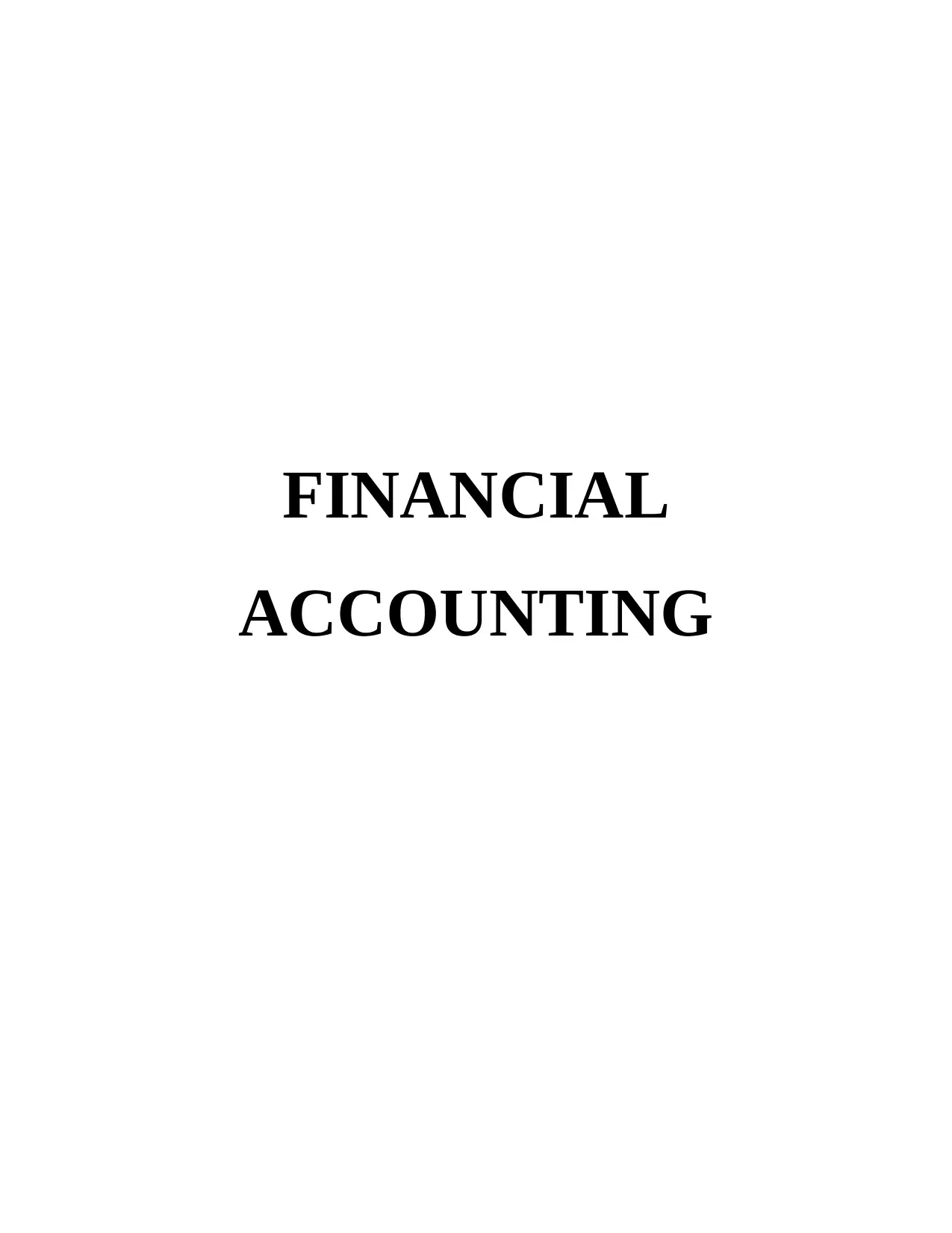
FINANCIAL
ACCOUNTING
ACCOUNTING
Paraphrase This Document
Need a fresh take? Get an instant paraphrase of this document with our AI Paraphraser

Table of Contents
INTRODUCTION...........................................................................................................................4
MAIN BODY...................................................................................................................................4
A) Define financial accounting and its purpose.....................................................................4
B) External and internal stakeholders and their interest in financial information of
organisation............................................................................................................................1
CLIENT 1........................................................................................................................................2
1) Journal entries....................................................................................................................2
2) Ledger accounts.................................................................................................................4
3) Trial Balance....................................................................................................................12
CLIENT 2......................................................................................................................................13
A) Profit statement ..............................................................................................................13
B) Balance sheet...................................................................................................................13
C) Consistency and prudence concepts................................................................................14
Consistency...........................................................................................................................14
Prudence...............................................................................................................................15
D) Depreciation objectives and methods of calculating depreciation..................................15
E) Distinguish between final report of sole proprietorship and limited companies.............16
CLIENT 3.....................................................................................................................................17
A) Meaning and purpose of BRS.........................................................................................17
B) Reasons of difference between cash and bank statements..............................................17
C) Concept of imprest under system of petty cash...............................................................18
D) Bank Reconciliation Statement of Burcu ltd...................................................................19
CLIENT 4......................................................................................................................................20
A) Sales and purchase ledger account .................................................................................20
B) control account................................................................................................................21
CLIENT 5......................................................................................................................................21
A) Suspense account and its characteristics.........................................................................21
B) Trial balance ...................................................................................................................22
c. Rectifying errors ..............................................................................................................22
INTRODUCTION...........................................................................................................................4
MAIN BODY...................................................................................................................................4
A) Define financial accounting and its purpose.....................................................................4
B) External and internal stakeholders and their interest in financial information of
organisation............................................................................................................................1
CLIENT 1........................................................................................................................................2
1) Journal entries....................................................................................................................2
2) Ledger accounts.................................................................................................................4
3) Trial Balance....................................................................................................................12
CLIENT 2......................................................................................................................................13
A) Profit statement ..............................................................................................................13
B) Balance sheet...................................................................................................................13
C) Consistency and prudence concepts................................................................................14
Consistency...........................................................................................................................14
Prudence...............................................................................................................................15
D) Depreciation objectives and methods of calculating depreciation..................................15
E) Distinguish between final report of sole proprietorship and limited companies.............16
CLIENT 3.....................................................................................................................................17
A) Meaning and purpose of BRS.........................................................................................17
B) Reasons of difference between cash and bank statements..............................................17
C) Concept of imprest under system of petty cash...............................................................18
D) Bank Reconciliation Statement of Burcu ltd...................................................................19
CLIENT 4......................................................................................................................................20
A) Sales and purchase ledger account .................................................................................20
B) control account................................................................................................................21
CLIENT 5......................................................................................................................................21
A) Suspense account and its characteristics.........................................................................21
B) Trial balance ...................................................................................................................22
c. Rectifying errors ..............................................................................................................22

CONCLUSION..............................................................................................................................24
REFERENCES..............................................................................................................................25
REFERENCES..............................................................................................................................25
⊘ This is a preview!⊘
Do you want full access?
Subscribe today to unlock all pages.

Trusted by 1+ million students worldwide
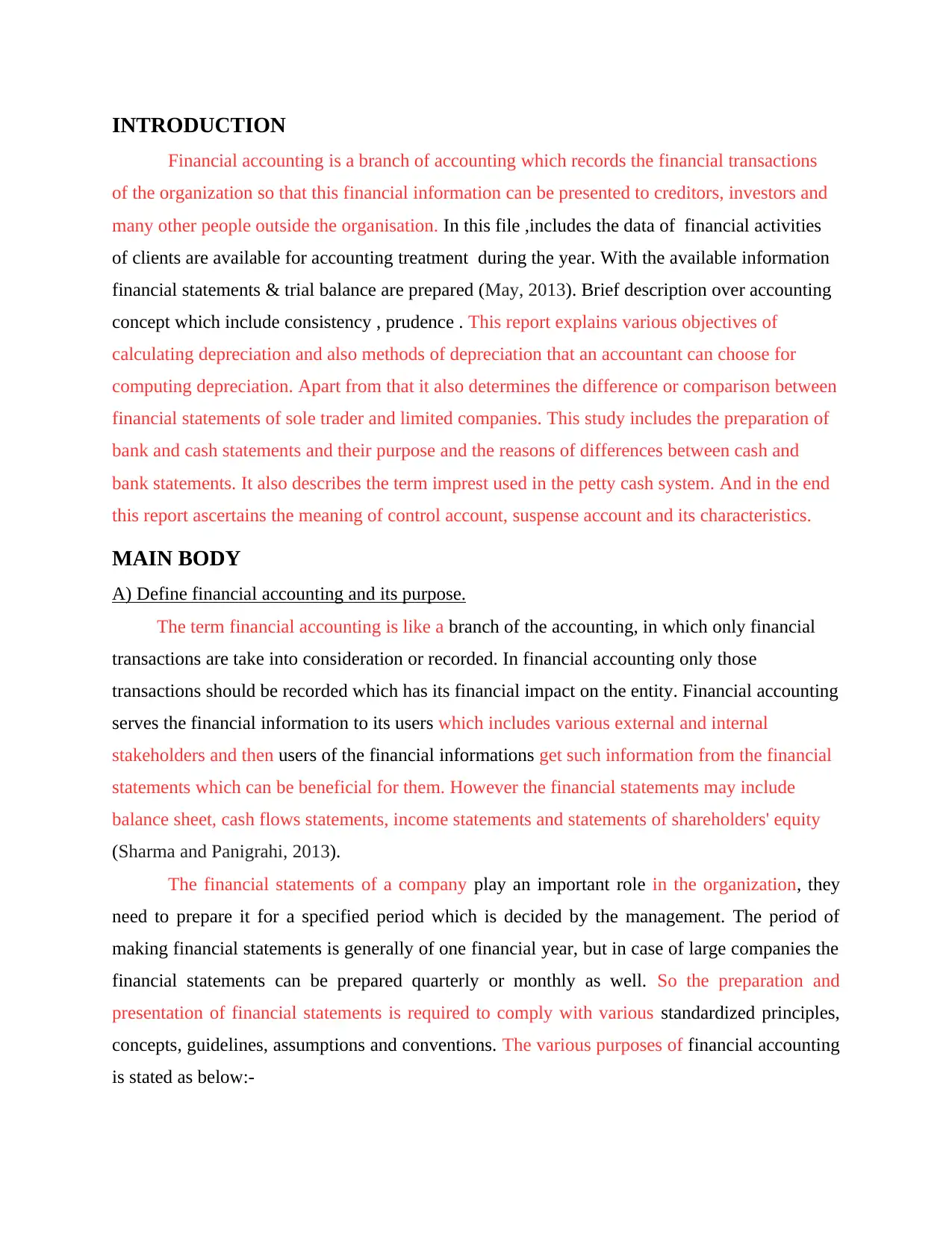
INTRODUCTION
Financial accounting is a branch of accounting which records the financial transactions
of the organization so that this financial information can be presented to creditors, investors and
many other people outside the organisation. In this file ,includes the data of financial activities
of clients are available for accounting treatment during the year. With the available information
financial statements & trial balance are prepared (May, 2013). Brief description over accounting
concept which include consistency , prudence . This report explains various objectives of
calculating depreciation and also methods of depreciation that an accountant can choose for
computing depreciation. Apart from that it also determines the difference or comparison between
financial statements of sole trader and limited companies. This study includes the preparation of
bank and cash statements and their purpose and the reasons of differences between cash and
bank statements. It also describes the term imprest used in the petty cash system. And in the end
this report ascertains the meaning of control account, suspense account and its characteristics.
MAIN BODY
A) Define financial accounting and its purpose.
The term financial accounting is like a branch of the accounting, in which only financial
transactions are take into consideration or recorded. In financial accounting only those
transactions should be recorded which has its financial impact on the entity. Financial accounting
serves the financial information to its users which includes various external and internal
stakeholders and then users of the financial informations get such information from the financial
statements which can be beneficial for them. However the financial statements may include
balance sheet, cash flows statements, income statements and statements of shareholders' equity
(Sharma and Panigrahi, 2013).
The financial statements of a company play an important role in the organization, they
need to prepare it for a specified period which is decided by the management. The period of
making financial statements is generally of one financial year, but in case of large companies the
financial statements can be prepared quarterly or monthly as well. So the preparation and
presentation of financial statements is required to comply with various standardized principles,
concepts, guidelines, assumptions and conventions. The various purposes of financial accounting
is stated as below:-
Financial accounting is a branch of accounting which records the financial transactions
of the organization so that this financial information can be presented to creditors, investors and
many other people outside the organisation. In this file ,includes the data of financial activities
of clients are available for accounting treatment during the year. With the available information
financial statements & trial balance are prepared (May, 2013). Brief description over accounting
concept which include consistency , prudence . This report explains various objectives of
calculating depreciation and also methods of depreciation that an accountant can choose for
computing depreciation. Apart from that it also determines the difference or comparison between
financial statements of sole trader and limited companies. This study includes the preparation of
bank and cash statements and their purpose and the reasons of differences between cash and
bank statements. It also describes the term imprest used in the petty cash system. And in the end
this report ascertains the meaning of control account, suspense account and its characteristics.
MAIN BODY
A) Define financial accounting and its purpose.
The term financial accounting is like a branch of the accounting, in which only financial
transactions are take into consideration or recorded. In financial accounting only those
transactions should be recorded which has its financial impact on the entity. Financial accounting
serves the financial information to its users which includes various external and internal
stakeholders and then users of the financial informations get such information from the financial
statements which can be beneficial for them. However the financial statements may include
balance sheet, cash flows statements, income statements and statements of shareholders' equity
(Sharma and Panigrahi, 2013).
The financial statements of a company play an important role in the organization, they
need to prepare it for a specified period which is decided by the management. The period of
making financial statements is generally of one financial year, but in case of large companies the
financial statements can be prepared quarterly or monthly as well. So the preparation and
presentation of financial statements is required to comply with various standardized principles,
concepts, guidelines, assumptions and conventions. The various purposes of financial accounting
is stated as below:-
Paraphrase This Document
Need a fresh take? Get an instant paraphrase of this document with our AI Paraphraser

To serve financial informations:- The main objective of financial accounting is to provide
or serve financial informations to its internal and external parties/ stakeholders as
stakeholders are the one who can affect or get affected by the doings, policies, rules and
regulations, plans and actions of company (Schaltegger and Burritt, 2017).
To record financial transactions:- This is another important purpose or objective of
financial accounting is to record and summarize financial transactions in the financial
statements or financial reports. This will ensures the understandability, relevancy and
comparability of the recorded financial transactions.
To plan the financial strategies:- As the financial informations is also for the internal
stakeholders or users or parties, because the employees of the company are involved in
financial activities, so, it become compulsory to plan financial strategies and also to make
sure the implementation of strategies as it is. This will further helpful in attract the
investors to invest in the company (Pratt, 2016).
To analyse financial position:- The other objective of financial accounting is to evaluate
financial position of the business concern or of the company. As further success of
company depends on its strong financial position. If organisation is financially healthy
then it will encourage the investors and lenders (such as: banking institutions) to invest
and lend credit to the company respectively, which will further ensures the sound
financial position of organisation.
To assess worth of the company:- As financial informations of company also affects the
external stakeholders/ users/ parties, so that they can assess the worth of the company for
themselves. The point is to consider here is that the financial reports are not the report to
show the value or the worth of the company, rather it is the report for the external
stakeholders to provide them the ease of assessment of the worth of the company for
themselves accordingly (Warren and Jones, 2018).
or serve financial informations to its internal and external parties/ stakeholders as
stakeholders are the one who can affect or get affected by the doings, policies, rules and
regulations, plans and actions of company (Schaltegger and Burritt, 2017).
To record financial transactions:- This is another important purpose or objective of
financial accounting is to record and summarize financial transactions in the financial
statements or financial reports. This will ensures the understandability, relevancy and
comparability of the recorded financial transactions.
To plan the financial strategies:- As the financial informations is also for the internal
stakeholders or users or parties, because the employees of the company are involved in
financial activities, so, it become compulsory to plan financial strategies and also to make
sure the implementation of strategies as it is. This will further helpful in attract the
investors to invest in the company (Pratt, 2016).
To analyse financial position:- The other objective of financial accounting is to evaluate
financial position of the business concern or of the company. As further success of
company depends on its strong financial position. If organisation is financially healthy
then it will encourage the investors and lenders (such as: banking institutions) to invest
and lend credit to the company respectively, which will further ensures the sound
financial position of organisation.
To assess worth of the company:- As financial informations of company also affects the
external stakeholders/ users/ parties, so that they can assess the worth of the company for
themselves. The point is to consider here is that the financial reports are not the report to
show the value or the worth of the company, rather it is the report for the external
stakeholders to provide them the ease of assessment of the worth of the company for
themselves accordingly (Warren and Jones, 2018).
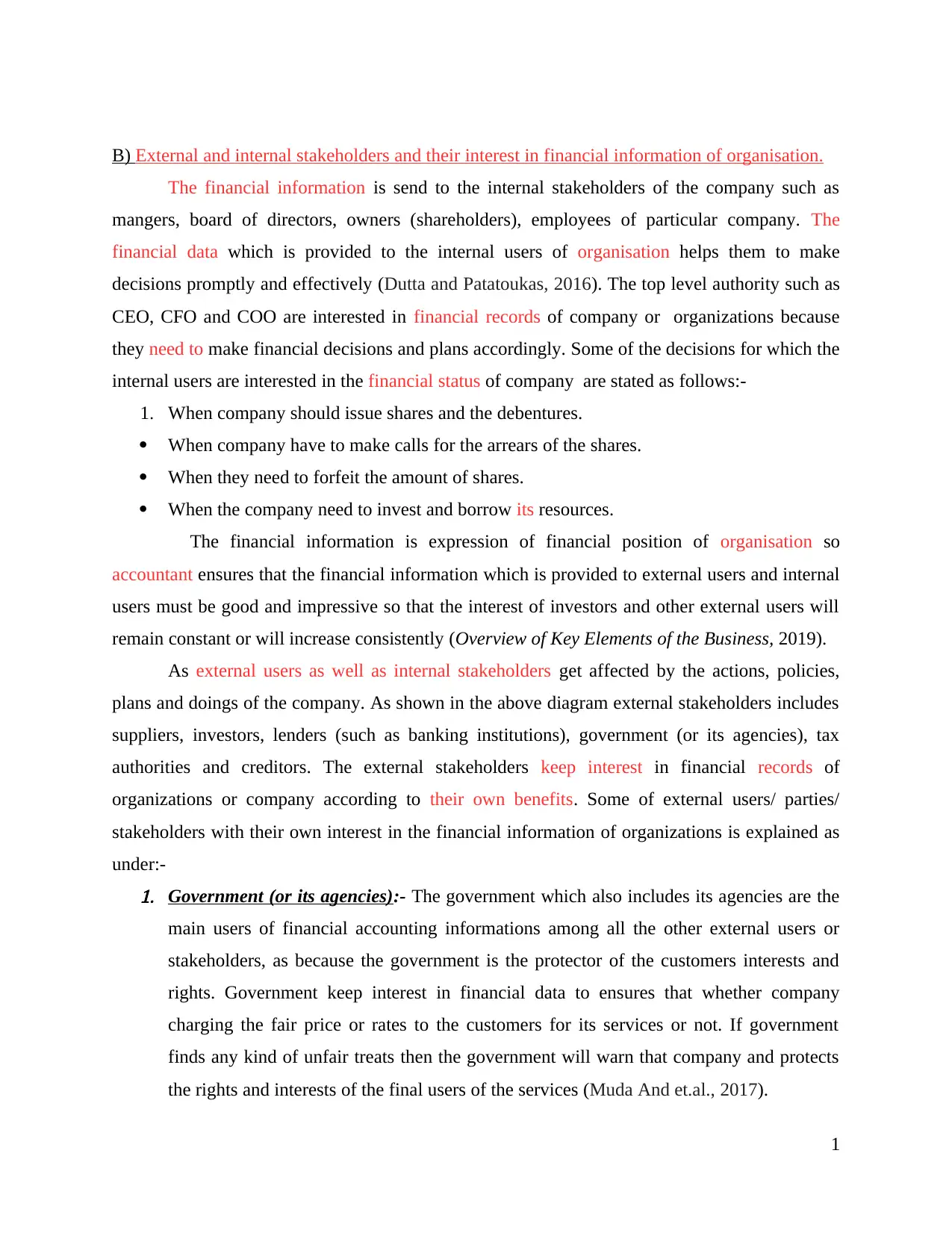
B) External and internal stakeholders and their interest in financial information of organisation.
The financial information is send to the internal stakeholders of the company such as
mangers, board of directors, owners (shareholders), employees of particular company. The
financial data which is provided to the internal users of organisation helps them to make
decisions promptly and effectively (Dutta and Patatoukas, 2016). The top level authority such as
CEO, CFO and COO are interested in financial records of company or organizations because
they need to make financial decisions and plans accordingly. Some of the decisions for which the
internal users are interested in the financial status of company are stated as follows:-
1. When company should issue shares and the debentures.
When company have to make calls for the arrears of the shares.
When they need to forfeit the amount of shares.
When the company need to invest and borrow its resources.
The financial information is expression of financial position of organisation so
accountant ensures that the financial information which is provided to external users and internal
users must be good and impressive so that the interest of investors and other external users will
remain constant or will increase consistently (Overview of Key Elements of the Business, 2019).
As external users as well as internal stakeholders get affected by the actions, policies,
plans and doings of the company. As shown in the above diagram external stakeholders includes
suppliers, investors, lenders (such as banking institutions), government (or its agencies), tax
authorities and creditors. The external stakeholders keep interest in financial records of
organizations or company according to their own benefits. Some of external users/ parties/
stakeholders with their own interest in the financial information of organizations is explained as
under:-1. Government (or its agencies):- The government which also includes its agencies are the
main users of financial accounting informations among all the other external users or
stakeholders, as because the government is the protector of the customers interests and
rights. Government keep interest in financial data to ensures that whether company
charging the fair price or rates to the customers for its services or not. If government
finds any kind of unfair treats then the government will warn that company and protects
the rights and interests of the final users of the services (Muda And et.al., 2017).
1
The financial information is send to the internal stakeholders of the company such as
mangers, board of directors, owners (shareholders), employees of particular company. The
financial data which is provided to the internal users of organisation helps them to make
decisions promptly and effectively (Dutta and Patatoukas, 2016). The top level authority such as
CEO, CFO and COO are interested in financial records of company or organizations because
they need to make financial decisions and plans accordingly. Some of the decisions for which the
internal users are interested in the financial status of company are stated as follows:-
1. When company should issue shares and the debentures.
When company have to make calls for the arrears of the shares.
When they need to forfeit the amount of shares.
When the company need to invest and borrow its resources.
The financial information is expression of financial position of organisation so
accountant ensures that the financial information which is provided to external users and internal
users must be good and impressive so that the interest of investors and other external users will
remain constant or will increase consistently (Overview of Key Elements of the Business, 2019).
As external users as well as internal stakeholders get affected by the actions, policies,
plans and doings of the company. As shown in the above diagram external stakeholders includes
suppliers, investors, lenders (such as banking institutions), government (or its agencies), tax
authorities and creditors. The external stakeholders keep interest in financial records of
organizations or company according to their own benefits. Some of external users/ parties/
stakeholders with their own interest in the financial information of organizations is explained as
under:-1. Government (or its agencies):- The government which also includes its agencies are the
main users of financial accounting informations among all the other external users or
stakeholders, as because the government is the protector of the customers interests and
rights. Government keep interest in financial data to ensures that whether company
charging the fair price or rates to the customers for its services or not. If government
finds any kind of unfair treats then the government will warn that company and protects
the rights and interests of the final users of the services (Muda And et.al., 2017).
1
⊘ This is a preview!⊘
Do you want full access?
Subscribe today to unlock all pages.

Trusted by 1+ million students worldwide
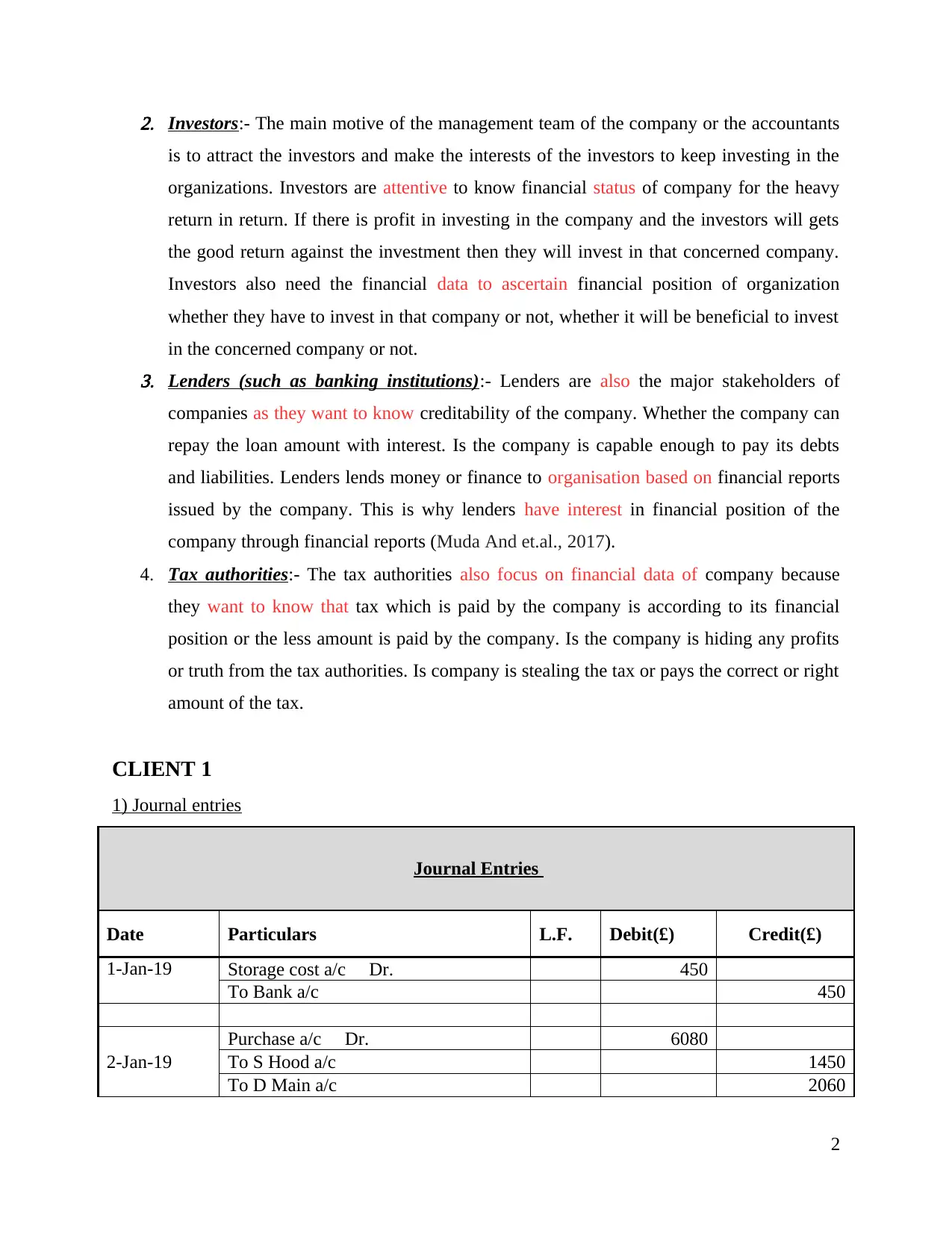
2. Investors:- The main motive of the management team of the company or the accountants
is to attract the investors and make the interests of the investors to keep investing in the
organizations. Investors are attentive to know financial status of company for the heavy
return in return. If there is profit in investing in the company and the investors will gets
the good return against the investment then they will invest in that concerned company.
Investors also need the financial data to ascertain financial position of organization
whether they have to invest in that company or not, whether it will be beneficial to invest
in the concerned company or not.3. Lenders (such as banking institutions):- Lenders are also the major stakeholders of
companies as they want to know creditability of the company. Whether the company can
repay the loan amount with interest. Is the company is capable enough to pay its debts
and liabilities. Lenders lends money or finance to organisation based on financial reports
issued by the company. This is why lenders have interest in financial position of the
company through financial reports (Muda And et.al., 2017).
4. Tax authorities:- The tax authorities also focus on financial data of company because
they want to know that tax which is paid by the company is according to its financial
position or the less amount is paid by the company. Is the company is hiding any profits
or truth from the tax authorities. Is company is stealing the tax or pays the correct or right
amount of the tax.
CLIENT 1
1) Journal entries
Journal Entries
Date Particulars L.F. Debit(£) Credit(£)
1-Jan-19 Storage cost a/c Dr. 450
To Bank a/c 450
2-Jan-19
Purchase a/c Dr. 6080
To S Hood a/c 1450
To D Main a/c 2060
2
is to attract the investors and make the interests of the investors to keep investing in the
organizations. Investors are attentive to know financial status of company for the heavy
return in return. If there is profit in investing in the company and the investors will gets
the good return against the investment then they will invest in that concerned company.
Investors also need the financial data to ascertain financial position of organization
whether they have to invest in that company or not, whether it will be beneficial to invest
in the concerned company or not.3. Lenders (such as banking institutions):- Lenders are also the major stakeholders of
companies as they want to know creditability of the company. Whether the company can
repay the loan amount with interest. Is the company is capable enough to pay its debts
and liabilities. Lenders lends money or finance to organisation based on financial reports
issued by the company. This is why lenders have interest in financial position of the
company through financial reports (Muda And et.al., 2017).
4. Tax authorities:- The tax authorities also focus on financial data of company because
they want to know that tax which is paid by the company is according to its financial
position or the less amount is paid by the company. Is the company is hiding any profits
or truth from the tax authorities. Is company is stealing the tax or pays the correct or right
amount of the tax.
CLIENT 1
1) Journal entries
Journal Entries
Date Particulars L.F. Debit(£) Credit(£)
1-Jan-19 Storage cost a/c Dr. 450
To Bank a/c 450
2-Jan-19
Purchase a/c Dr. 6080
To S Hood a/c 1450
To D Main a/c 2060
2
Paraphrase This Document
Need a fresh take? Get an instant paraphrase of this document with our AI Paraphraser
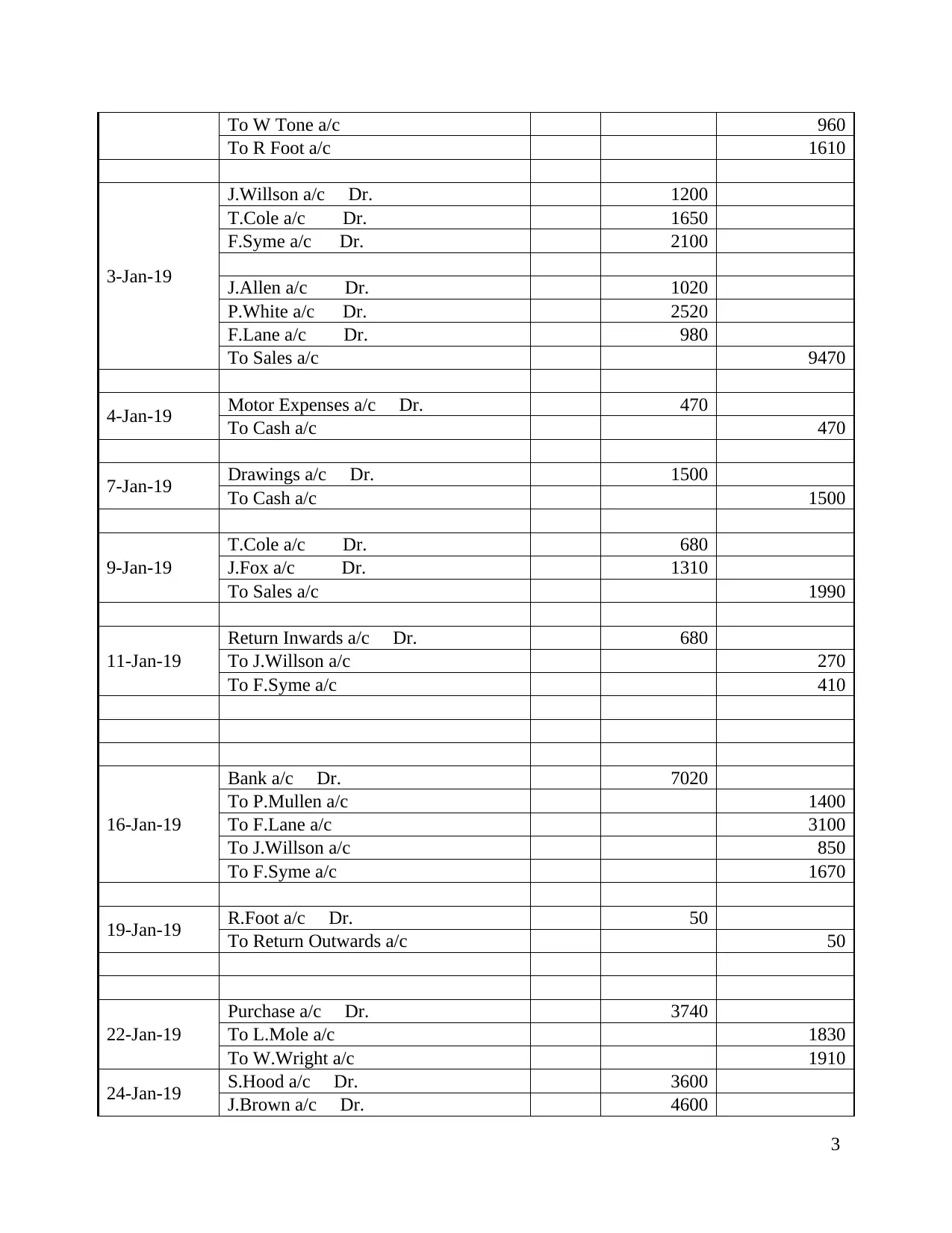
To W Tone a/c 960
To R Foot a/c 1610
3-Jan-19
J.Willson a/c Dr. 1200
T.Cole a/c Dr. 1650
F.Syme a/c Dr. 2100
J.Allen a/c Dr. 1020
P.White a/c Dr. 2520
F.Lane a/c Dr. 980
To Sales a/c 9470
4-Jan-19 Motor Expenses a/c Dr. 470
To Cash a/c 470
7-Jan-19 Drawings a/c Dr. 1500
To Cash a/c 1500
9-Jan-19
T.Cole a/c Dr. 680
J.Fox a/c Dr. 1310
To Sales a/c 1990
11-Jan-19
Return Inwards a/c Dr. 680
To J.Willson a/c 270
To F.Syme a/c 410
16-Jan-19
Bank a/c Dr. 7020
To P.Mullen a/c 1400
To F.Lane a/c 3100
To J.Willson a/c 850
To F.Syme a/c 1670
19-Jan-19 R.Foot a/c Dr. 50
To Return Outwards a/c 50
22-Jan-19
Purchase a/c Dr. 3740
To L.Mole a/c 1830
To W.Wright a/c 1910
24-Jan-19 S.Hood a/c Dr. 3600
J.Brown a/c Dr. 4600
3
To R Foot a/c 1610
3-Jan-19
J.Willson a/c Dr. 1200
T.Cole a/c Dr. 1650
F.Syme a/c Dr. 2100
J.Allen a/c Dr. 1020
P.White a/c Dr. 2520
F.Lane a/c Dr. 980
To Sales a/c 9470
4-Jan-19 Motor Expenses a/c Dr. 470
To Cash a/c 470
7-Jan-19 Drawings a/c Dr. 1500
To Cash a/c 1500
9-Jan-19
T.Cole a/c Dr. 680
J.Fox a/c Dr. 1310
To Sales a/c 1990
11-Jan-19
Return Inwards a/c Dr. 680
To J.Willson a/c 270
To F.Syme a/c 410
16-Jan-19
Bank a/c Dr. 7020
To P.Mullen a/c 1400
To F.Lane a/c 3100
To J.Willson a/c 850
To F.Syme a/c 1670
19-Jan-19 R.Foot a/c Dr. 50
To Return Outwards a/c 50
22-Jan-19
Purchase a/c Dr. 3740
To L.Mole a/c 1830
To W.Wright a/c 1910
24-Jan-19 S.Hood a/c Dr. 3600
J.Brown a/c Dr. 4600
3
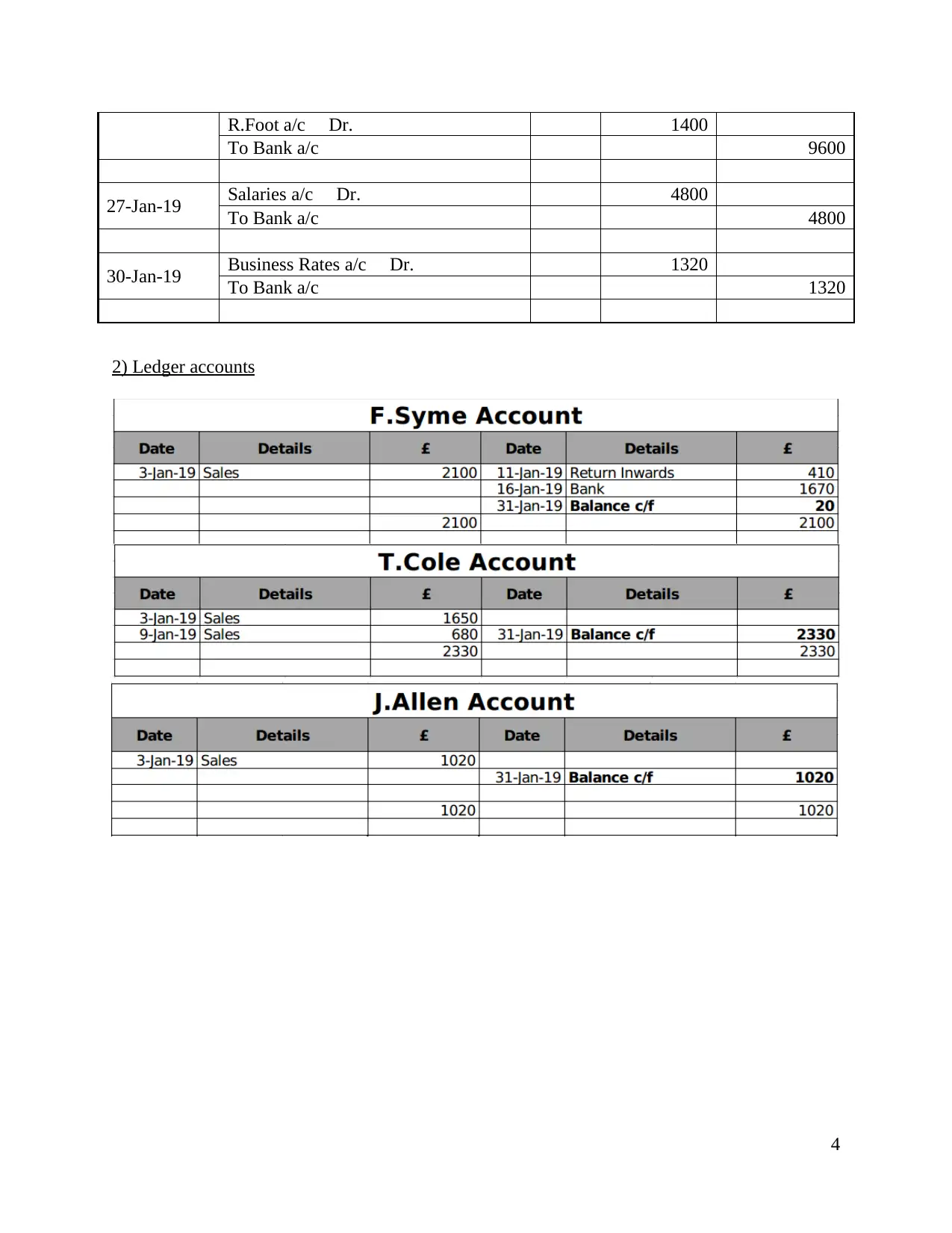
R.Foot a/c Dr. 1400
To Bank a/c 9600
27-Jan-19 Salaries a/c Dr. 4800
To Bank a/c 4800
30-Jan-19 Business Rates a/c Dr. 1320
To Bank a/c 1320
2) Ledger accounts
4
To Bank a/c 9600
27-Jan-19 Salaries a/c Dr. 4800
To Bank a/c 4800
30-Jan-19 Business Rates a/c Dr. 1320
To Bank a/c 1320
2) Ledger accounts
4
⊘ This is a preview!⊘
Do you want full access?
Subscribe today to unlock all pages.

Trusted by 1+ million students worldwide
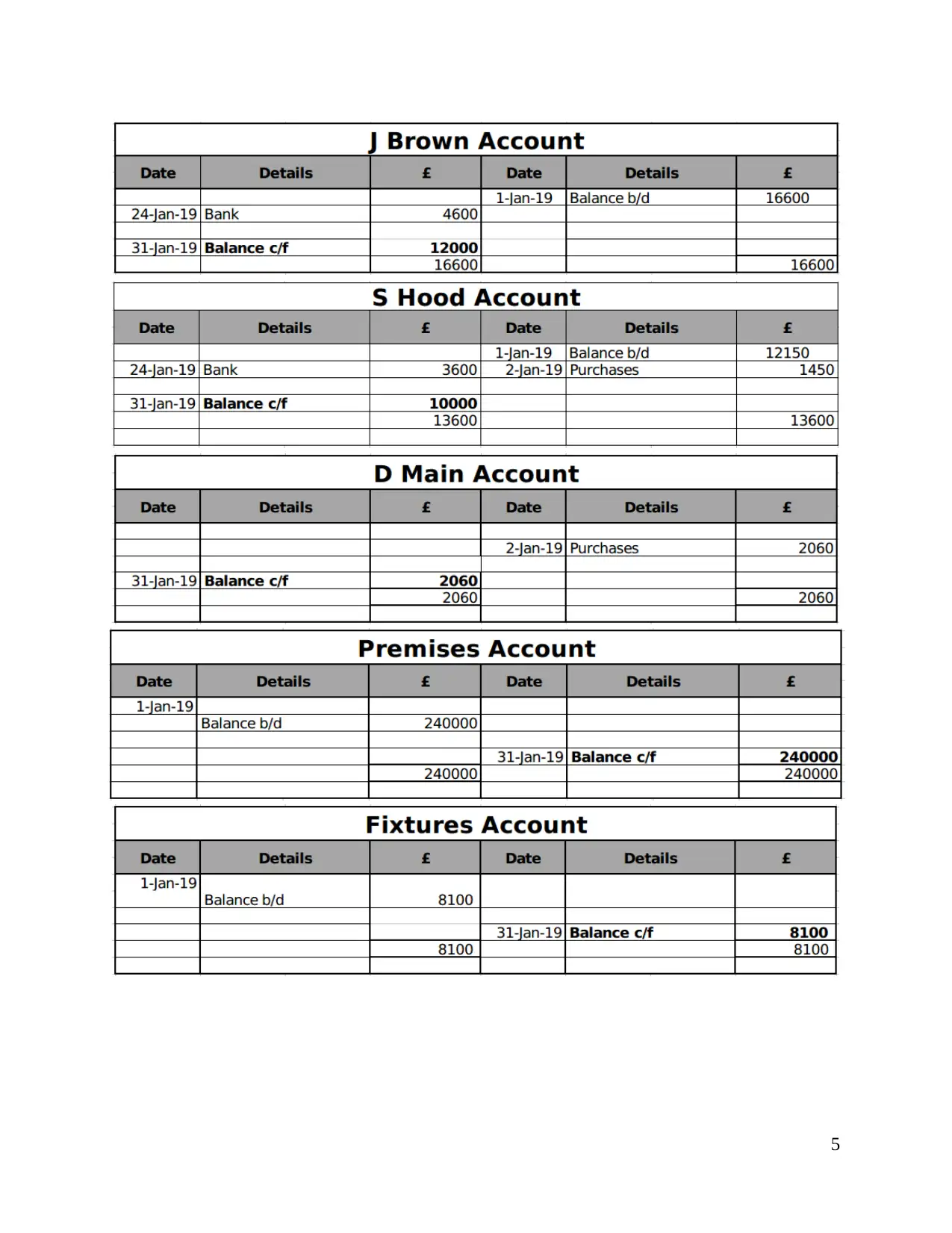
5
Paraphrase This Document
Need a fresh take? Get an instant paraphrase of this document with our AI Paraphraser

6
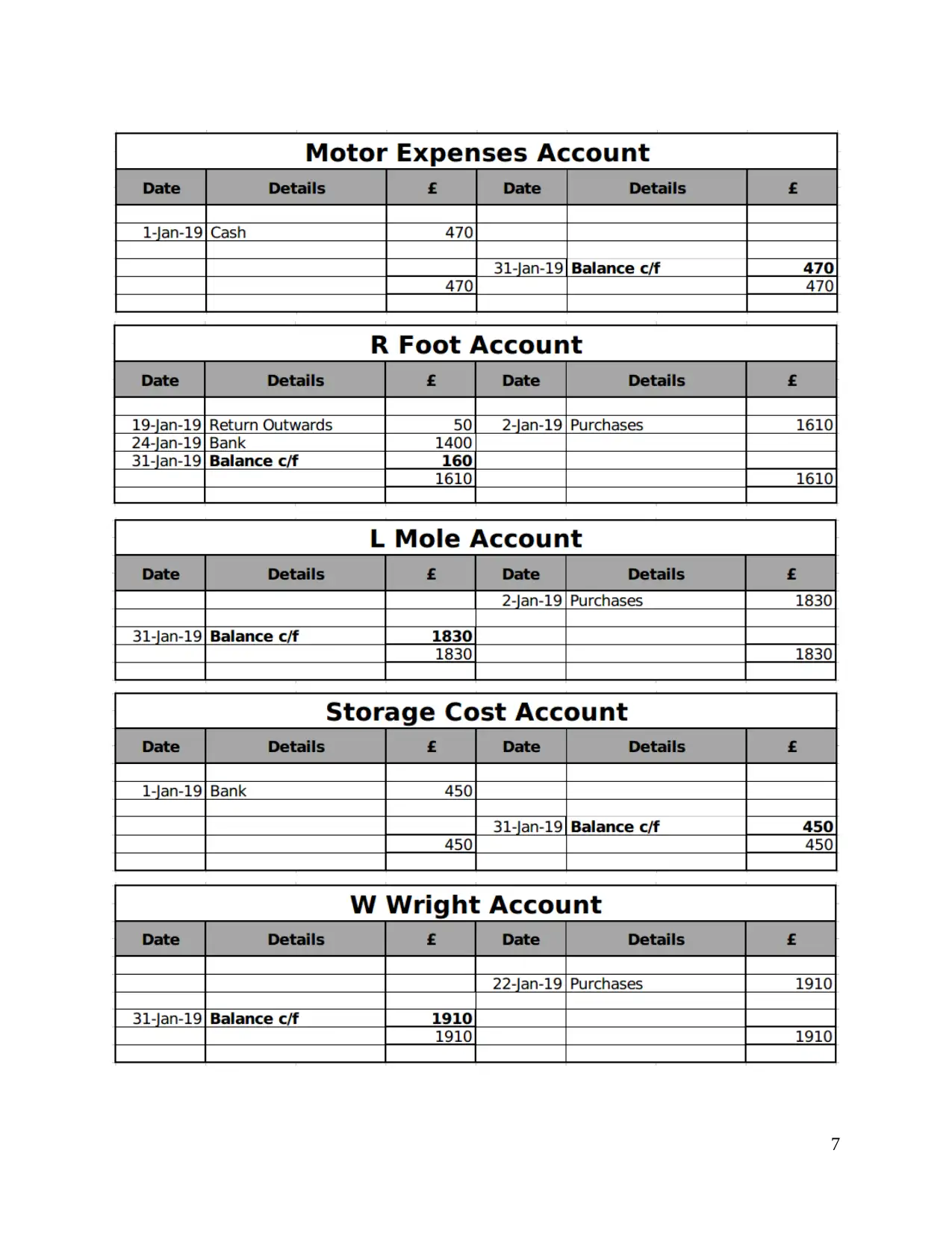
7
⊘ This is a preview!⊘
Do you want full access?
Subscribe today to unlock all pages.

Trusted by 1+ million students worldwide
1 out of 30
Related Documents
Your All-in-One AI-Powered Toolkit for Academic Success.
+13062052269
info@desklib.com
Available 24*7 on WhatsApp / Email
![[object Object]](/_next/static/media/star-bottom.7253800d.svg)
Unlock your academic potential
Copyright © 2020–2025 A2Z Services. All Rights Reserved. Developed and managed by ZUCOL.





